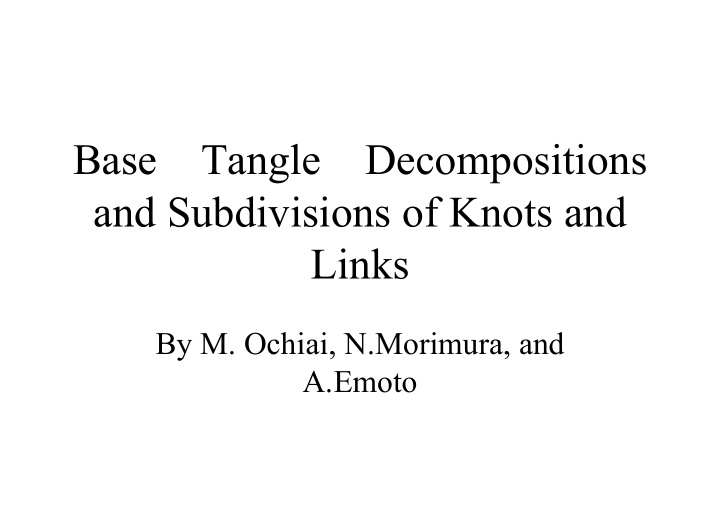



Base Tangle Decompositions and Subdivisions of Knots and Links By M. Ochiai, N.Morimura, and A.Emoto
HOMFLY invariant of Knot or Link For a knot or link K, (1)P(K;x,y) = 1 if K is the trivial knot (2) x P(K+;x,y) + y P(K-;x,y) = P(K ∞ ;x,y)
Let T be a 2-string tangle. x P(T+;x,y) + y P(T-;x,y) = P(T ∞ ;x,y) K = T1 + T2, wheren K is a knot and T1 ,T2 are tangles. P(T1; x,y) = a1 A1 + b1 B1 P(T2; x,y) = a2 A2 + b2 B2, P(K;x,y)=a1a2(A1+A2)+a1b2(A1+B2)+ b1a2(B1+A2)+b1b2(B1+B2) Where A1, B1, A2, B2 are base tangles. A tangle T is called by a base tangle if (1) T has minimal crossings with only plus sign.
Tangle decomposition of Conway’s knot
n-tangle decomposition(n>2) Base tangle by using oriented ordered • tangle (1) Minimal crossings (2) First string has only over (resp. under) crossings, second string has also over (resp. under) crossings other than crossing with the first string,….
Reconstruction of a base tangle from a sequence • Our first method uses to make a base tangle from a sequence by using small deformations of string end points (The last version). • The second method makes to classify n-multiple points which have models of n double points. This program made by Miss A. Emoto. And this program can make n string base tangles with up to 12. But practically, up to 9-string, in this case there exists 9! base tangles.
The base tangle decomposition of the first tangle of Terasaka’s knot
The base tangle decomposition of the second tangle of Terasaka’s knot
The 3-parallel HOMFLY polynomial of Terasaka’s knot
Final computation of base tangle decomposition
How to compute the 3-parallel HOMFLY polynomial of the following knot with 15-crossings
Obstruction of subdivision • Usual base decompositions are applied to 2 different strings and so no “free loops” are generated. • Tangle subdivision generates at most three free loops.
Subdivision programs composition(0, 12, 12, 12, 0, 0, NULL); >> knot , link composition(1, 12, 18, 9, p, q, base); composition 696() >> 9-string composition(2, 12, 18, 6, p, q, base); composition699() >> 6-string composition(3, 12, 12, 6, p, q, base); composition666() >> 6-string composition(4, 18, 18, 6, p, q, base); composition9912() >> 6-string
Recommend
More recommend